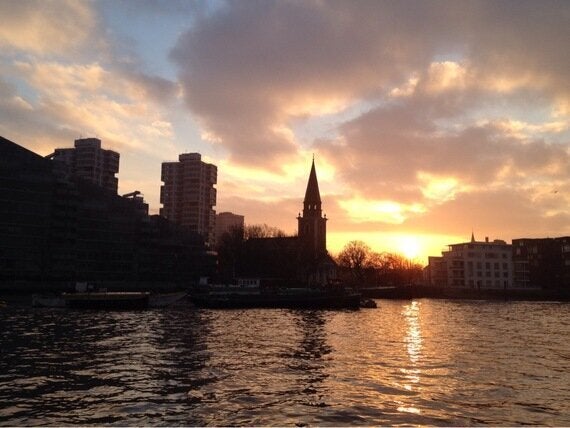My father grew up playing on the Battersea riverfront. He once built a motorboat in the back garden with his father. He remembers the spring morning sixty years ago he pushed it down the slipway outside St Mary's church and into the Thames.
I first moved to Battersea's riverfront in my twenties, renting a room from a friend in Molasses House at Plantation Wharf. I loved living next to the water.
When he visited me, my father was astonished by the pace of change - which seems to accelerate each year. More than 18,000 new homes are currently planned in the Nine Elms area.
Last week I was contacted by a local woman concerned that a 28-storey development is planned a short walk from her home.
"I feel safe here", she tells me. She bought her riverside flat in the early 90s. "My friends are close by, so I didn't want to move away. But I felt vulnerable in our family home, so I downsized. Now, I can sit on my balcony, enjoy the sunshine and watch the boats go up and down the river."
"The riverfront is changing quickly", she says, "and not always for the best."
The restaurant a few doors down frequently changes hands. "Every time I walked past it was empty." The local pub was sold to developers. There are few coffee shops in the area and no supermarket. "Property prices have gone up and up, yet less people seem to live here."
More and more properties are vacant, bought for investment purposes rather than as a home. Over half of the first 835 homes at Battersea Power Station were sold to overseas buyers. Other homes on the riverfront are used for rolling short-term executive lets.
I too, have seen our riverfront change. There are fewer lights on. Flats look empty. At night, Battersea's Thames Path can be eerily quiet.
The Conservatives tell us that thousands of homes are under construction. Yet, we still face a housing crisis in London, with rents up 15% in a year and spiraling house prices putting buying a home out of reach for young families. We're building new homes, but not the right type of homes. Just three of the first 2,400 flats to be built on the Battersea Power Station site will be affordable, family-sized homes.
The marketing documents for new developments pitch at certain demographics: the young and the affluent. It's wine bars and alfresco dining, not even a Waitrose, nor a Boots. It's a million miles from the urban grit of Wandsworth's run-down council estates.
Local civic groups The Battersea Society and The Putney Society accuse the council of ignoring its own guidelines when it comes to large property developments. Labour councillor Simon Hogg says the council consistently puts the interests of developers ahead of local residents and accuses Wandsworth council of running "a property empire with a sideline in local government".
The 28-storey development under consideration is on a plot that is just 2,300 metres squared. Only one in ten homes will be affordable, below the local Conservative council's own policy target. The plans will tower over nearby flats. The developer tells me they couldn't afford to reduce the height. Maybe, just maybe, they paid too much for the land.
A short walk away, a Homebase on York Road recently sold to developers for £52 million.
The regeneration of Battersea's once-industrial riverfront is an opportunity to create vibrant, integrated communities. We can improve public access along the riverfront Thames Path, create jobs with bustling riverside cafés, restaurants and a cultural scene - and build homes that local people can afford to rent or buy.
Above all, I want to bring balance to Thames-side developments.
This is our riverfront. It's part of our shared heritage, not simply a strip of real estate. We would do well to remember Battersea Council's old motto: Not for you, not for me, but for us.
The riverfront belongs to us - and to all the Battersea boys and girls who dream of building a boat and sailing out to sea.
